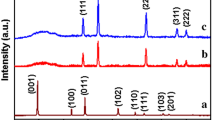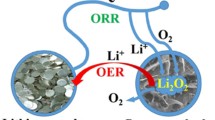Abstract
High-tap density electrode materials are greatly desired for Li-ion batteries with high volumetric capacities to fulfill the growing demands of electric vehicles and portable smart devices. TiO2, which is one of the most attractive anode materials, is limited in their application for Li-ion batteries because of its low tap density (usually <1 g cm−3) and volumetric capacity. Herein, we report uniform mesoporous TiO2 submicrospheres with a tap density as high as 1.62 g cm−3 as a promising anode material. Even with a high mass loading of 24 mg cm−2, the TiO2 submicrospheres have impressive volumetric capacities that are more than double those of their counterparts. Moreover, they can be synthesized with ~100% yield and within a reaction time of ~6 h by optimizing the experimental conditions and formation mechanism, exhibiting potential for large-scale production for industrial applications. Other mesoporous anode materials, i.e., high-tap density mesoporous Li4Ti5O12 submicrospheres, are fabricated using the generalizedmethod. We believe that our work provides a significant reference for the industrial production of mesoporous materials for Li-ion batteries with a high volumetric performance.
摘要
随着人们对电动汽车和可穿戴电子产品需求的增加, 开发具有高体积比容量的锂离子二次电池非常必要, 特别是制备高振实密度的电极材料尤为重要. TiO2是一种具有应用前景的阳极材料, 然而它们的振实密度普遍较低(通常小于<1 g cm−3). 本论文报道了一种均匀的亚微米级TiO2介孔球, 其振实密度高达1.62 g cm−3. 以其作为锂离子二次电池的阳极材料时, 在高达24 mg cm−2的负载量的情况下, TiO2介孔球的体积比容量比其他对比TiO2材料的体积比容量高出2倍之多. 制备该TiO2介孔球仅需6 h的反应时间且产率接近100%, 因此其工业化生产可能性很大. 此外, 该制备方法的普适性非常好,其他高振实密度介孔材料, 如亚微米级Li4Ti5O12介孔球, 也可采用类似方法制备. 因此,本工作可为工业化制备高振实密度介孔材料及其在高体积比容量锂离子二次电池中的应用提供重要借鉴.
Similar content being viewed by others
References
Gogotsi Y, Simon P. True performance metrics in electrochemical energy storage. Science, 2011, 334: 917–918
Ghidiu M, Lukatskaya MR, Zhao MQ, et al. Conductive two-dimensional titanium carbide ‘clay’ with high volumetric capacitance. Nature, 2014, 516: 78–81
Zhang C, Yang QH. Packing sulfur into carbon framework for high volumetric performance lithium-sulfur batteries. Sci ChinaMater, 2015, 58: 349–354
Saravanan K, Ananthanarayanan K, Balaya P. Mesoporous TiO2 with high packing density for superior lithium storage. Energy Environ Sci, 2010, 3: 939–948
Liang J, Yu XY, Zhou H, et al. Bowl-like SnO2@carbon hollow particles as an advanced anode material for lithium-ion batteries. Angew Chem Int Ed, 2014, 53: 12803–12807
Wagemaker M, Mulder FM. Properties and promises of nanosized insertion materials for Li-ion batteries. Acc Chem Res, 2013, 46: 1206–1215
Li W, Wu Z, Wang J, et al. A perspective on mesoporous TiO2 materials. Chem Mater, 2014, 26: 287–298
Qiu B, Xing M, Zhang J. Mesoporous TiO2 nanocrystals grown in situ on graphene aerogels for high photocatalysis and lithium-ion batteries. J Am Chem Soc, 2014, 136: 5852–5855
Liu Y, Che R, Chen G, et al. Radially orientedmesoporous TiO2microspheres with single-crystal-like anatase walls for high-efficiency optoelectronic devices. Sci Adv, 2015, 1: e1500166
Liu Y, Elzatahry AA, Luo W, et al. Surfactant-templating strategy for ultrathin mesoporous TiO2 coating on flexible graphitized carbon supports for high-performance lithium-ion battery. Nano Energy, 2016, 25: 80–90
Guan BY, Yu L, Li J, et al. A universal cooperative assembly-directedmethod for coating ofmesoporous TiO2 nanoshells with enhanced lithium storage properties. Sci Adv, 2016, 2: e1501554
Yu XY, Wu HB, Yu L, et al. Rutile TiO2 submicroboxes with superior lithium storage properties. Angew Chem Int Ed, 2015, 54: 4001–4004
Saito M, Nakano Y, Takagi M, et al. Improvement of tap density of TiO2(B) powder as high potential negative electrode for lithium ion batteries. J Power Sources, 2013, 244: 50–55
Chen D, Caruso RA. Recent progress in the synthesis of spherical titania nanostructures and their applications. Adv Funct Mater, 2013, 23: 1356–1374
Liu H, Bi Z, Sun XG, et al. Mesoporous TiO2-B microspheres with superior rate performance for lithium ion batteries. Adv Mater, 2011, 23: 3450–3454
Trang NTH, Ali Z, Kang DJ. Mesoporous TiO2 spheres interconnected by multiwalled carbon nanotubes as an anode for high-performance lithium ion batteries. ACS Appl Mater Interfaces, 2015, 7: 3676–3683
Zhu K, Tian J, Liu Y, et al. Submicron-sized mesoporous anatase TiO2 beads with a high specific surface synthesized by controlling reaction conditions for high-performance Li-batteries. RSC Adv, 2013, 3: 13149–13155
Zhao T, Luo W, Deng Y, et al. Monodisperse mesoporous TiO2 microspheres for dye sensitized solar cells. Nano Energy, 2016, 26: 16–25
Zhang Y, Shi Y, Liou YH, et al. High performance separation of aerosol sprayed mesoporous TiO2 sub-microspheres from aggregates via density gradient centrifugation. J Mater Chem, 2010, 20: 4162–4167
Hong MP, Kim JY, Vemula K, et al. Synthesis of monodisperse mesoporous TiO2 spheres with tunable sizes between 0.6 and 3.1 μm and effects of reaction temperature, Ti source purity, and type of alkylamine on size and monodispersity. Chem Commun, 2012, 48: 4250–4252
Chen D, Cao L, Huang F, et al. Synthesis of monodisperse mesoporous titania beads with controllable diameter, high surface areas, and variable pore diameters (14−23 nm). J Am Chem Soc, 2010, 132: 4438–4444
Yan K, Qiu Y, Chen W, et al. A double layered photoanode made of highly crystalline TiO2 nanooctahedra and agglutinated mesoporous TiO2 microspheres for high efficiency dye sensitized solar cells. Energy Environ Sci, 2011, 4: 2168–2176
Roh DK, Seo JA, Chi WS, et al. Facile synthesis of size-tunable mesoporous anatase TiO2 beads using a graft copolymer for quasisolid and all-solid dye-sensitized solar cells. J Mater Chem, 2012, 22: 11079–11085
Wang L, Tomura S, Maeda M, et al. Synthesis of mesoporous TiO2 spheres under static condition. Chem Lett, 2000, 29: 1414–1415
Duan Y, Fu N, Fang Y, et al. Synthesis and formation mechanism of mesoporous TiO2 microspheres for scattering layer in dye-sensitized solar cells. Electrochim Acta, 2013, 113: 109–116
Wang Y, Tang X, Yin L, et al. Sonochemical synthesis of mesoporous titanium oxide with wormhole-like framework structures. Adv Mater, 2000, 12: 1183–1186
Zhang L, Yu JC. A sonochemical approach to hierarchical porous titania spheres with enhanced photocatalytic activity. Chem Commun, 2003, 9: 2078
Wang HE, Jin J, Cai Y, et al. Facile and fast synthesis of porous TiO2 spheres for use in lithium ion batteries. J Colloid Interface Sci, 2014, 417: 144–151
Widoniak J, Eiden-Assmann S, Maret G. Synthesis and characterisation of porous and non-porous monodisperse TiO2 and ZrO2 particles. Colloids Surfaces A-Physicochem Eng Aspects, 2005, 270–271: 329–334
Tsung CK, Fan J, Zheng N, et al. A general route to diverse mesoporousmetal oxide submicrospheres with highly crystalline frameworks. Angew Chem Int Ed, 2008, 47: 8682–8686
Das SK, Darmakolla S, Bhattacharyya AJ. High lithium storage in micrometre sized mesoporous spherical self-assembly of anatase titania nanospheres and carbon. J Mater Chem, 2010, 20: 1600
Tong H, Enomoto N, InadaM, et al. Synthesis ofmesoporous TiO2 spheres and aggregates by sol-gel method for dye-sensitized solar cells. Mater Lett, 2015, 141: 259–262
Liu H, Li W, Shen D, et al. Graphitic carbon conformal coating of mesoporous TiO2 hollow spheres for high-performance lithium ion battery anodes. J Am Chem Soc, 2015, 137: 13161–13166
Liu H, Ma H, Joo J, et al. Contribution of multiple reflections to light utilization efficiency of submicron hollow TiO2 photocatalyst. Sci China Mater, 2016, 59: 1017–1026
Jin J, Huang SZ, Liu J, et al. Phases hybriding and hierarchical structuring of mesoporous TiO2 nanowire bundles for high-rate and high-capacity lithium batteries. Adv Sci, 2015, 2: 1500070
Lin C, Fan X, Xin Y, et al. Monodispersed mesoporous Li4Ti5O12 submicrospheres as anodematerials for lithium-ion batteries: morphology and electrochemical performances. Nanoscale, 2014, 6: 6651–6660
Shin JY, Samuelis D, Maier J. Sustained lithium-storage performance of hierarchical, nanoporous anatase TiO2 at high rates: emphasis on interfacial storage phenomena. Adv Funct Mater, 2011, 21: 3464–3472
Ali Z, Cha SN, Sohn JI, et al. Design and evaluation of novel Zn doped mesoporous TiO2 based anode material for advanced lithium ion batteries. J Mater Chem, 2012, 22: 17625–17629
Hao R, Jiang B, Li M, et al. Fabrication of mixed-crystalline-phase spindle-like TiO2 for enhanced photocatalytic hydrogen production. Sci China Mater, 2015, 58: 363–369
Liu Y, Lan K, Li S, et al. Constructing three-dimensional mesoporous bouquet-posy-like TiO2 superstructures with radially oriented mesochannels and single-crystal walls. J Am Chem Soc, 2017, 139: 517–526
Han T, Chen Y, Tian G, et al. Hydrogenated TiO2/SrTiO3 porous microspheres with tunable band structure for solar-light photocatalytic H2 and O2 evolution. Sci China Mater, 2016, 59: 1003–1016
Acknowledgments
This work was supported by the National High Technology Research and Development Program of China (2013AA050901), the National Basic Research Program of China (2015CB251100), the Thousand Youth Talents Program, theNationalNatural Science Foundation of China (51602173, 51371015 and 11674023), and China Postdoctoral Science Foundation (2016M591186). We thank Prof. Jiaping Wang, Fei Zhao, and Yufeng Luo for their help with the N2 adsorption/desorption measurements.
Author information
Authors and Affiliations
Corresponding authors
Additional information
Kunlei Zhu obtained his PhD degree at Tianjin University in 2015, and is now a postdoctoral research fellow at Tsinghua University. His research interests are focused on the syntheses ofmesoporousmaterials and 2D materials for energy storage.
Zhongqiang Shan was born in 1957. He is a full professor at Tianjin University. His current research interests are focused on the energy storgae devices including Li-ion battries, Li-S batteries and supercapacitors.
Kai Liu obtained his PhD degree at Tsinghua University in 2008. He joined Tsinghua University as an associtate professor in 2015 after a period of postdoctoral research at Lawrence-Berkeley National Lab. His current research focuses on the mechanical and electrical properties of low-dimensinal materials and their applications.
Electronic supplementary material
40843_2016_9002_MOESM1_ESM.pdf
Fast synthesis of uniform mesoporous titania submicrospheres with high tap densities for high-volumetric performance Li-ion batteries
Rights and permissions
About this article
Cite this article
Zhu, K., Sun, Y., Wang, R. et al. Fast synthesis of uniform mesoporous titania submicrospheres with high tap densities for high-volumetric performance Li-ion batteries. Sci. China Mater. 60, 304–314 (2017). https://doi.org/10.1007/s40843-016-9002-y
Received:
Accepted:
Published:
Issue Date:
DOI: https://doi.org/10.1007/s40843-016-9002-y




